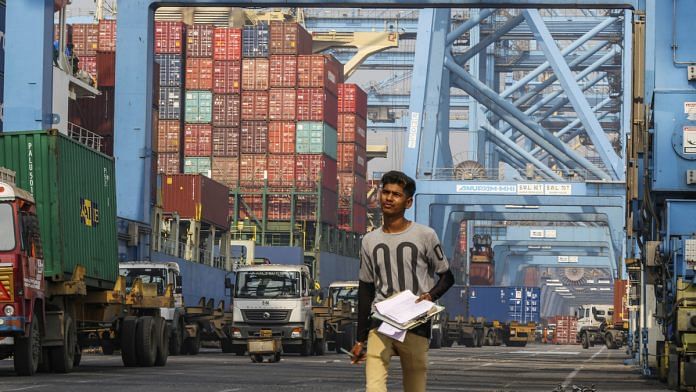New Delhi: India’s new measures announced Saturday to revive a flagging economy through an aid to exporters isn’t as big a boost as the initial numbers suggested.
The help to traders by way of tax refunds for export promotion would cost the government just an additional 90 billion ($1.3 billion) a year, a review of budget numbers show. The new program will subsume existing export incentives, for which the government had already penciled in a revenue hit of Rs 41,000 crore in July.
On Saturday, Finance Minister Nirmala Sitharaman said the tax refund program for exporters from Jan. 1 will cost the government Rs 50,000 crore ($7 billion) in revenue annually. India will separately set up a Rs 10,000 crore-funding window for affordable housing to revive stalled projects, she told reporters in New Delhi while unveiling what was her ministry’s third set of measures in four weeks to boost growth.
Exporters will benefit from tax incentives, refunds and improved credit and insurance cover, while the real estate sector will get access to last-mile funding for affordable housing projects provided they haven’t been declared as non-performing asset or pushed to insolvency proceedings, she said.
The measures are the latest in a series of steps announced by the government to boost consumer demand and attract investments in an economy that’s seen growth decelerate to a six-year-low. Prime Minister Narendra Modi has been under pressure from industry groups and political opponents to use the fiscal space afforded to him last month by a more than $24 billion windfall from the Reserve Bank of India.
“It’s better for exports than housing, but not a game changer,” said Teresa John, an economist with Nirmal Bang Equities Pvt. “There were no significant measures to boost housing demand, and disappointed expectation, and hence may negatively impact real estate stocks.”
A possible flare up in oil prices after the drone attacks in Saudi Arabia could negate any impact from Sitharaman’s measures in the short term. India imports 80% of its oil requirement and an increase in crude prices may put further pressure on the rupee, which has dropped 2% in the past three months.
The government will make every effort to ensure that the revenue loss from the latest measures won’t affect the fiscal deficit target, Sitharaman said. In July, she set a goal to narrow the budget gap to 3.3% of gross domestic product in the year ending March 2020.
“I’m conscious of it,” Sitharaman said. “I will do as much as possible to stick to it.”
The support to exporters is key for Asia’s third-largest economy, which is seeking to triple annual overseas sales to $1 trillion in five years. Exports have dropped in two of the three months to August despite a weaker rupee. A trade war between the U.S. and China, and a weakening global economy further risk damping demand for India’s pharmaceutical products, garments and steel.
One of the biggest changes is quicker refund of local taxes “which has been a pain for exporters,” Sharad Kumar Saraf, president of the Federation of Indian Export Organisations said in an interview with BloombergQuint. “It will help the cash flow at exporters.”
Not Enough
The measures “seem to come in tranches, rather than at one go,” Sitharaman said, referring to some steps unveiled earlier to boost growth. “But each time we’re making a clear attempt to also to connect with the previous announcements that we have made.”
She said the funding window for affordable residential projects, along with easier foreign borrowing rules for housing, will help builders access money for reviving stalled projects.
Not all are convinced. The move to revive homes sales — hit by a series of economic shocks — may not be enough, said Jaxay Shah, chairman of the Confederation of Real Estate Developers Association of India.
The Reserve Bank of India last month lowered its growth forecast for the economy to 6.9% for the year to March, while cutting interest rates by a cumulative 110 basis points so far this year.
“So far we have a demand side problem which is leading to lower growth and inflation,” said Indranil Pan, chief economist at IDFC First Bank. “The measures so far announced address supply side issues. So they shouldn’t have much of an impact.” –Bloomberg
Also read: Modi govt has set another daunting target – tripling exports to $1 trillion in next 5 yrs






